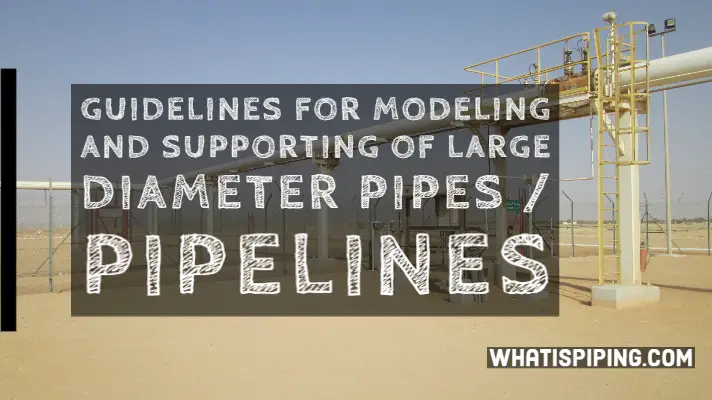Small-bore piping is defined as pipes that are 2 inches or less in size. In the piping industry, pipes are categorized into two groups; small-bore pipes and large-bore pipes. Any pipe having a size of more than 2 inches is termed a large bore pipe. Whereas piping systems carrying pipes of two inches or less are considered small-bore piping systems. Some organizations consider a 2″ pipe size as large-bore.
Small-bore Pipe Sizes
The usual pipe diameters that are frequently used in small bore pipe connections are
- 1/8″
- 1/4″
- 3/8″
- 1/2″
- 3/4″
- 1″
- 1-1/4″
- 1-1/2″ and
- 2″
Most of the time these lines are instrument connections, drain connections, sampling connections, or vent connections. Almost in all large bore piping systems, there will be some small bore pipe connections. In general small-bore piping is considered non-critical and usually does not require detailed pipe stress analysis. Small-bore pipe sizes usually branch off from the large-bore main pipes.
As very little attention is provided for the design and support of small bore pipe connections in both the process and power piping industry, these pipes sometimes become the cause of pipe vibration and failures impacting the reliability of the complete piping system.
Small-bore piping supports
Small-bore pipes are generally site-supported. In general, they are supported by taking support from nearby large-bore lines. Clamp supports are the most frequently and widely used small-bore piping supports. In absence of nearby parallel large-bore piping, simple steel members are used for support. As small bore pipes do not impose large support loads, the supports are not designed specifically. The following guidelines can be applied for supporting small-bore piping systems:
- Overhang and unsupported spans for small-bore pipe connections need to be minimized.
- Support shall be provided near the mass and stress concentration points to reduce the fatigue failure potential.
- Supporting from the main pipe is preferred such that the small-bore connection moves along with the parent pipe during start-up, shutdown, thermal transients, etc.
- Neoprene pad, PTFE pad, etc can be used to dampen vibration when supporting vibration-prone lines.
- Large vertical runs should be avoided and a guide needs to be provided to reduce vibration tendency.
- The bracing connections if provided between the small bore pipework and the parent line should be in two planes. Also, the bracing shall never be taken from local structures.
- If the geometry of small bore piping is difficult to support, it must be re-routed to provide support easily.
Small-bore pipes connected to high-temperature large-bore pipes
Small-bore pipe connections that are connected to high-temperature large-bore main pipes must be stress analyzed. For example, small-bore drain piping from high-pressure steam lines needs to be stress analyzed to provide proper flexibility that will be arising from the high temperature of the main pipe. Enough flexibility needs to be provided so that the branch connection interface does not fail due to excessive stress generation.
Vibration in Small-bore pipe connections
Due to the geometry and mass, it carries, small-bore piping connections are prone to vibration. Even a vibration of a very low amplitude vibration on the main piping can lead to excessive vibration in the small-bore branch connection and eventually may break due to fatigue failure.
Design Considerations for Small-bore Pipe Connections
Considering the flexibility and vibration potential of small-bore pipe connections, their sizes are sometimes limited during application as branch connections. The following guidelines can be used in general:
- Process team to review if unnecessary small-piping can be avoided in the plant.
- As the failure tendency for small bore piping increases with an increase in cantilever arm length, small bore piping must be routed to have an as small arm as possible.
- Larger piping is preferable for mechanical strength consideration instead of using support bracing for small bore piping.
- For direct mounted instrument connections, the minimum size of branch connections to run pipes shall be 3/4″ from 3/4″ through 2″ run pipe, 1″ from NPS 3 through 12, and NPS 1-1/2 for run pipes greater than NPS 12.
- The location of small bore tappings shall be decided as close to rigid supports on the main pipe as possible.
- To reduce vibration tendency and increase the mechanical strength of instrument connections bracing can be provided to the run pipe.
- Non-direct mounted instrument connections from small-bore piping need to be minimized as possible.
- Pipes with long branch connections are required to be braced.
- Small bore pipe connections shall be avoided in piping directly connected to compressors, nozzles, or pulsation bottles.
- The small bore piping connected to the flare tip must be designed to withstand the flare radiation temperature and flare tip thermal movement.
- While providing stiffeners in small bore piping the differential expansion must be checked. For example, while supporting small bore piping that is connected with pipes or equipment with large thermal movement the differential thermal movement and stress generated must be evaluated.
- Sufficient rigidity must be provided for small bore piping systems which are prone to vibration.
- It is preferable to avoid socket welded fittings for small bore connections as those weld points create a weak link.
- After installation of the plant, a site review must be planned to check all small bore pipe connections to find any problems with support.
Online Video Courses on Piping Support
To learn more about piping support design and engineering you can opt for the following video course.









Thank you so much Anup. I am also a Mechanical Engineer aspiring to be a Piping Engineer too. I hope to connect with you and be under your tutorship if possible.
Thank you so much…you are making the process of learning very easier for everyone…God bless you